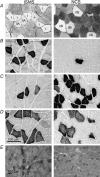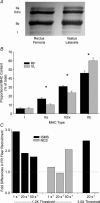Intraspinal microstimulation preferentially recruits fatigue-resistant muscle fibres and generates gradual force in rat
- PMID: 16239281
- PMCID: PMC1464280
- DOI: 10.1113/jphysiol.2005.094516
Intraspinal microstimulation preferentially recruits fatigue-resistant muscle fibres and generates gradual force in rat
Abstract
Intraspinal microstimulation (ISMS), a novel rehabilitative therapy consisting of stimulation through fine, hair-like microwires targeted at the ventral spinal cord, has been proposed for restoring standing and walking following spinal cord injury. This study compared muscle recruitment characteristics of ISMS with those produced by peripheral nerve cuff stimulation (NCS). Thirty-three minutes of either ISMS or NCS at 1, 20 or 50 s(-1) and 1.2 x threshold (T) amplitude depleted glycogen from muscle fibres of vastus lateralis and rectus femoris. ISMS and NCS were also carried out at 20 s(-1) and 3.0T. Muscle serial sections were stained for glycogen and for myosin heavy chain (MHC)-based fibre types using a panel of monoclonal antibodies. The results of this study show that ISMS recruited fatigue-resistant (FR) fibres at 2.9, 1.9, 1.7 and 2.5 times their relative MHC content at 1, 20 and 50 s(-1) 1.2T and 20 s(-1) 3.0T, respectively. In contrast, NCS recruited FR fibres at 1.2, 1.0, 2.1 and 0.0 times their MHC content at 1, 20 and 50 s(-1) 1.2T and 20 s(-1) 3.0T, respectively. The proportion of FR fibres recruited by ISMS and NCS was significantly different in the 20 s(-1) 3.0T condition (P < 0.0001). We also report that force recruitment curves were 4.9-fold less steep (P < 0.019) for ISMS than NCS. The findings of this study provide evidence for the efficacy of ISMS and further our understanding of muscle recruitment properties of this novel rehabilitative therapy.
Figures






References
-
- Agnew WF, McCreery DB. Neural Prostheses: Fundamental Studies. Englewood Cliffs, NJ, USA: Prentice Hall; 1990.
-
- Andersen JL, Mohr T, Biering-Sorensen F, Galbo H, Kjaer M. Myosin heavy chain isoform transformation in single fibres from m. vastus lateralis in spinal cord injured individuals: effects of long-term functional electrical stimulation (FES) Pflugers Arch. 1996;431:513–518. - PubMed
-
- Aoyagi Y, Mushahwar VK, Stein RB, Prochazka A. Movements elicited by electrical stimulation of muscles, nerves, intermediate spinal cord, and spinal roots in anesthetized and decerebrate cats. IEEE Trans Neural Syst Rehabil Eng. 2004;12:1–11. - PubMed
-
- Bamford JA, Lopaschuk GD, MacLean IM, Reinhart ML, Dixon WT, Putman CT. Effects of chronic AICAR administration on the metabolic and contractile phenotypes of rat slow- and fast-twitch skeletal muscles. Can J Physiol Pharmacol. 2003;81:1072–1082. - PubMed
-
- Bowers-Komro DM, Yamada Y, McCormick DB. Substrate specificity and variables affecting efficiency of mammalian flavin adenine dinucleotide synthetase. Biochemistry. 1989;28:8439–8446. - PubMed
Publication types
MeSH terms
Substances
LinkOut - more resources
Full Text Sources
Other Literature Sources
Research Materials

